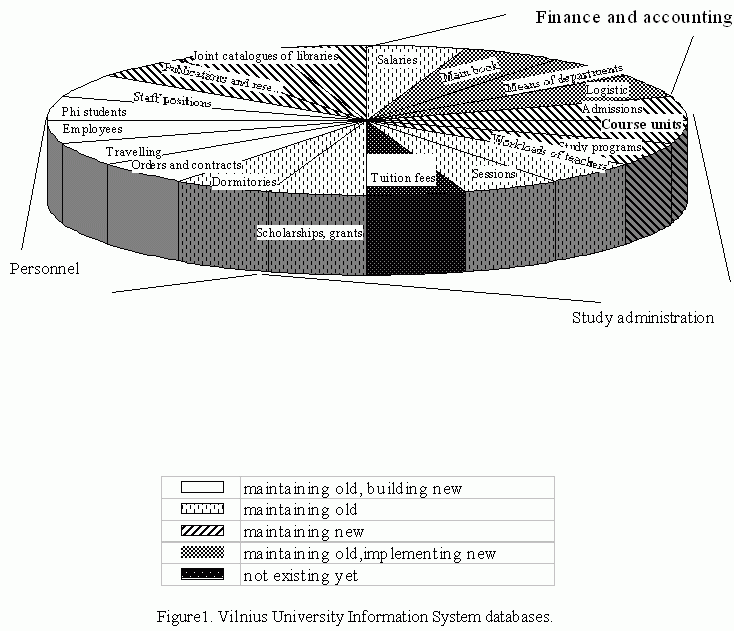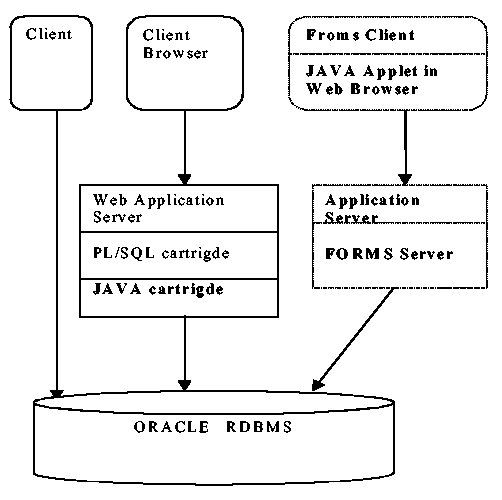New version of information system (IS) is under development in Vilnius University. Both the client/server and three-tier architecture are used for IS implementation. Read-only IS users have access only to replicated data.
At present Vilnius University Information System (IS) consists of such main databases: Accounting, Admission, Student, Personnel, Dormitories, Research and Library. Those databases were created at different times using different software development tools and are in completely different Information Technology (IT) environments - from local area networks to IBM mainframe with dumb terminals. The design of was mostly created according to the needs of the customers and users, which reside in the main central offices of university. Figure 1 represents parts of Vilnius University IS.

On the other hand, one of main aim of Vilnius University management reform is to delegate decision-making issues, which are currently concentrated in the central level to the faculties. There is a need for a new IT environment which will be enable to use IS for mostly all independent units of university. So, the new version of Information System (IS) was started to design and develop in Vilnius University since beginning of 1997.
At present the client/server architecture is main IT environment for the new Vilnius University IS. Oracle7 RDBMS [1] is running on a Sun Sparc Server and is used for database management. Oracle Designer/2000 is used to design and Developer/2000 is used for building applications on a client side. Data flow is based on SQL*Net protocol. On the other hand, the majority of IS users are read-only users. In this case, three-tier architecture is a solution. Figure 2 represents present technological architecture of Vilnius University IS (punctuation means, that these parts are under implementation).

Figure 2. Technological architecture of the new Integrated Information system of Vilnius University.
The client deals with the application server, and the application server with the database. HTML, HTTPD and Web server/database integration is the tool for delivering information over the Internet (for Web-based client). Oracle Application Server utilises a three-tier architecture (Oracle Application Server is employed for making data accessible over the World Wide Web). Oracle Application Server is sitting with Oracle7 database, which contains read-only copies of data from primary remote database. Such approach used for publications and research works database. Course unit applications are fully implemented using three-tier architecture; that is, Web-based users can insert, update and search data on primary database. Authorised users on faculty level using client browser through PL/SQL cartridge insert, update and search Course unit database.
Different security methods are used depending on data sensitivity. The Account database is implemented using client/server architecture and such technological approach in this case, we think, is the most suitable. Only authorised information providers are able post information. IP filtering is used for the identification of client sites. Database access is possible only using finance-accounting application. Control sum checking tells about unauthorised changes in data.
For databases (now Admission and Research databases), which are accessible by Internet there are read-only users. Data replication to enhance data security is the case. Benefits of exposure read-only snapshot [2] rather than the master table itself to WWW includes:
For Web applications which deals with data manipulation (insert, delete, update) we use Domain Name Restriction method and Basic Authentication.
It is considered to deploy Dveloper/2000 applications on Web using for this purpose Developer/2000 Server. This will allow running client/server applications in a three-tier environment based on cartridge implementation. Also in near future JAVA cartridge will be employed for delivering Web-based applications.
Oracle7 Server Concepts, Release 7.3. Oracle Corporation, 1997.
Oracle7 Server Distributed Systems, Vol.II, Release 7.3.Oracle Corporation, 1997.
Marijus Jurgutis,
Sauletekio al.9 II-jungt.k. Skaiciavimo centras
Vilnius 2054, Lithuania
E-mail : Marijus.Jurgutis@sc.vu.lt
Gediminas Murauskas
Sauletekio al.9 II-jungt.k. Skaiciavimo centras
Vilnius 2054, Lithuania
E-mail : Gediminas.Murauskas@maf.vu.lt